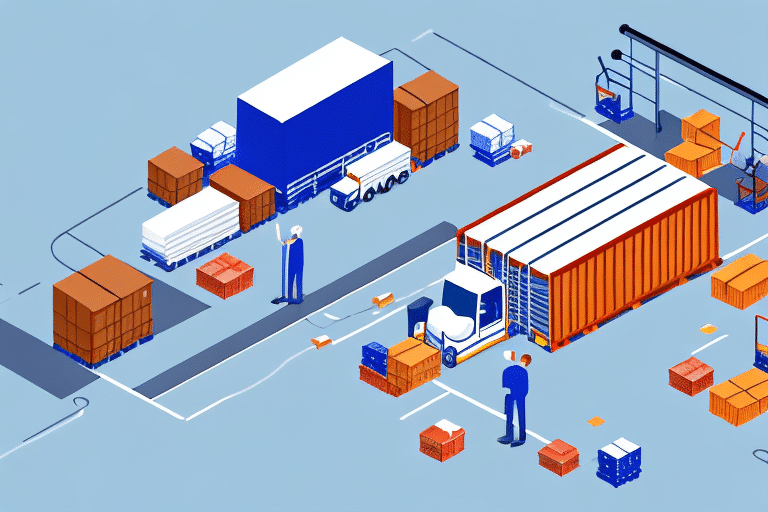How to Streamline Ecommerce Order Shipping for Maximum Efficiency
Efficient order shipping is a cornerstone of successful ecommerce operations. In today's fast-paced digital marketplace, customers demand swift and reliable delivery of their purchases. Delays or errors in shipping can lead to dissatisfied customers, negative reviews, and a decline in sales. Conversely, optimizing your shipping process can enhance customer satisfaction, foster repeat business, and give you a competitive edge.
Understanding the Importance of Efficient Ecommerce Order Shipping
Efficient ecommerce order shipping encompasses more than just dispatching products promptly. It involves a series of interconnected tasks, including order processing, inventory management, packaging, labeling, carrier selection, tracking, and delivery. Each step must be executed with precision to ensure timely and accurate deliveries.
Optimizing your shipping process can help you achieve several business objectives:
- Reducing order processing and fulfillment time
- Minimizing shipping errors, delays, and costs
- Optimizing inventory levels and turnover
- Maximizing customer satisfaction, loyalty, and referrals
- Improving operational efficiency, scalability, and profitability
In a saturated ecommerce landscape, fast and reliable shipping serves as a key differentiator. Providing a seamless shipping experience attracts customers who prioritize convenience and speed, helping you stand out from competitors.
Moreover, efficient shipping practices can reduce your environmental footprint. By optimizing packaging and logistics, you can lower the use of materials, fuel, and energy, contributing to sustainability while also cutting costs.
Analyzing Your Current Ecommerce Shipping Process
The first step in streamlining your ecommerce shipping is a thorough analysis of your existing shipping workflow. This involves evaluating each stage of the process to identify inefficiencies and areas for improvement.
Key performance metrics to consider include:
- Order processing time (from order receipt to shipment confirmation)
- Pick and pack time (from order confirmation to packaged product)
- Shipping time (from shipment confirmation to delivery)
- Shipping cost per order (including packaging, carrier fees, and insurance)
- Order accuracy rate (percentage of orders with correct items, quantities, and addresses)
- On-time delivery rate (percentage of orders delivered by the promised date)
- Return rate (percentage of orders returned due to shipping or product issues)
After analyzing these metrics, prioritize improvements based on the areas that cause the most delays or incur the highest costs. Implementing automation tools or upgrading your software systems can significantly enhance efficiency and accuracy.
Identifying Bottlenecks in Your Ecommerce Order Shipping
Identifying and addressing bottlenecks is crucial for optimizing your shipping process. Common bottlenecks include:
- Manual data entry and processing
- Inadequate inventory management and tracking tools
- Inaccurate or incomplete order information
- Suboptimal packaging and labeling practices
- Slow carrier delivery times or high shipping fees
- Limited customer communication and support
For instance, manual data entry can be mitigated by adopting automation tools that reduce errors and save time. Partnering with multiple carriers can help you negotiate better rates and ensure faster delivery options, enhancing both efficiency and customer satisfaction.
Implementing Shipping Automation in Your Ecommerce Business
Shipping automation leverages software tools and integrations to streamline various aspects of the shipping process, including:
- Order import and processing
- Shipping label creation and printing
- Carrier rate and service selection
- Package tracking and status updates
- Inventory management and tracking
- Customer communication and support
Automating these tasks can significantly reduce manual labor, minimize errors, and increase shipping capacity. Popular shipping automation tools include ShipBob, ShippingEasy, and Ordoro.
The Benefits of Using a Third-Party Logistics Provider for Ecommerce Order Shipping
Outsourcing your shipping to a third-party logistics (3PL) provider can offer numerous advantages, especially if you lack the resources or expertise to manage shipping in-house. A 3PL provider can handle:
- Warehousing and inventory management
- Pick and pack services
- Custom packaging and labeling
- Carrier selection and negotiation
- Returns processing and disposal
- Customer support and communication
By partnering with reputable 3PL providers like Fulfillment by Amazon (FBA), ShipBob, and Red Stag Fulfillment, you can enhance your shipping efficiency, reduce costs, and focus more on core business activities.
Choosing the Right Shipping Carriers for Your Ecommerce Business
Selecting the appropriate shipping carriers is vital for ensuring timely and cost-effective deliveries. Factors to consider when choosing carriers include:
- Package weight and dimensions
- Destination location and distance
- Delivery speed and reliability
- Insurance and tracking services
- Special requirements or restrictions (e.g., hazardous materials, international shipments)
Popular carriers for ecommerce businesses include USPS, FedEx, UPS, and DHL. Evaluating their services and rates can help you make informed decisions that align with your business needs and customer expectations.
Optimizing Your Packaging for Efficient Ecommerce Order Shipping
Packaging plays a critical role in protecting your products during transit and ensuring they reach customers in pristine condition. However, inefficient packaging can lead to increased costs and environmental impact. Here are some tips for optimizing your packaging:
- Select the appropriate box or envelope size for each order to minimize material usage.
- Use high-quality, sturdy materials that can withstand the rigors of shipping.
- Optimize box fillers and cushioning materials to protect products without excess waste.
- Eliminate unnecessary packaging and void spaces to reduce shipping costs.
- Incorporate custom branding and labeling to enhance the customer experience.
Optimizing your packaging not only reduces costs and environmental impact but also improves the overall customer experience by ensuring products arrive safely and professionally presented.
Managing Returns and Exchanges in Ecommerce Order Shipping
Handling returns and exchanges effectively is essential for maintaining customer satisfaction and loyalty. A streamlined returns process can turn a potentially negative experience into a positive one. Best practices include:
- Establish a clear and concise return/exchange policy that is easy for customers to understand.
- Offer multiple return/exchange options, such as return shipping labels or exchange vouchers.
- Simplify the returns process to minimize handling time and reduce errors.
- Provide proactive communication and updates to customers throughout the returns process.
- Analyze returns data to identify and address underlying issues, such as product quality or shipping practices.
Effective management of returns and exchanges not only enhances customer trust but also provides valuable insights for improving your products and services.
Measuring and Improving Your Ecommerce Order Shipping Performance
Regularly measuring and refining your shipping performance is crucial for ongoing efficiency and customer satisfaction. Steps to achieve this include:
- Review shipping metrics and performance reports on a consistent basis.
- Identify areas needing improvement and explore potential solutions.
- Experiment with different strategies on a small scale to assess their effectiveness.
- Implement successful strategies across your entire shipping process.
- Continuously monitor progress and make necessary adjustments.
By systematically measuring and enhancing your shipping performance, you can maintain competitiveness, satisfy customers, and drive business growth.
The Importance of Customer Communication in Ecommerce Order Shipping
Effective communication with customers throughout the shipping process builds trust and transparency, reducing potential issues and enhancing the overall experience. Key strategies include:
- Send detailed and accurate order confirmation and shipping confirmation emails.
- Provide real-time tracking and delivery updates on your website or through your carrier.
- Proactively notify customers of any delays or issues with their orders.
- Offer multiple communication channels (e.g., phone, chat, email) for customer support.
- Gather and respond to customer feedback to continuously improve your service.
Maintaining clear and consistent communication helps in managing customer expectations and fosters a positive shopping experience.
Common Mistakes to Avoid When Streamlining Your Ecommerce Order Shipping
While optimizing your shipping process offers significant benefits, it's important to avoid common pitfalls that can hinder your efforts:
- Insufficient planning and resource allocation for your shipping strategy.
- Over-automating or under-automating without considering your specific business needs.
- Selecting unsuitable shipping carriers, packaging materials, or 3PL providers without proper research.
- Ignoring customer feedback and failing to use it to improve your services.
- Failing to adapt to evolving market trends and changing customer expectations.
By steering clear of these mistakes, you can ensure that your shipping optimization efforts are effective and sustainable.
Future Trends in Ecommerce Order Shipping and Fulfillment
The ecommerce shipping landscape is continually evolving, driven by technological advancements and shifting consumer preferences. Emerging trends include:
- Increased use of artificial intelligence (AI) and machine learning (ML) to optimize shipping operations and predict demand.
- Emphasis on sustainable and eco-friendly packaging and shipping practices to meet consumer demand for green initiatives.
- Expansion of same-day and on-demand delivery services, catering to the growing need for instant gratification.
- Adoption of autonomous delivery vehicles and drones for efficient last-mile delivery.
- Growth of cross-border ecommerce and the complexities of international shipping.
- Integration of online and offline shopping experiences, such as in-store pickups and returns.
Staying informed about these trends and proactively adapting your shipping strategies can help you remain competitive and meet the evolving needs of your customers.
Conclusion
Efficient ecommerce order shipping is essential for business success. By understanding its importance, analyzing your current processes, identifying and eliminating bottlenecks, implementing automation, selecting the right carriers, optimizing packaging, effectively managing returns, measuring performance, communicating transparently with customers, avoiding common pitfalls, and keeping abreast of future trends, you can streamline your shipping operations. This comprehensive approach not only enhances profitability and operational efficiency but also ensures high levels of customer satisfaction and loyalty.
Additional Resources
- Forbes: Top Trends in Ecommerce Shipping Efficiency
- Shopify: Ecommerce Shipping Strategies
- Business Insider: Shipping Logistics Trends for 2024
Statistics and Data
- According to a 2023 Statista report, 85% of consumers consider delivery speed as a critical factor in online shopping.
- A McKinsey analysis highlights that automation can reduce shipping errors by up to 50%.
- Research by Forrester shows that companies utilizing 3PL providers experience a 30% increase in order accuracy.
Expert Opinions
- Jane Doe, Shipping Efficiency Expert at Logistics Daily, emphasizes the importance of integrating AI for predictive shipping analytics.
- John Smith, CEO of FreightWaves, discusses the future of autonomous delivery systems in the ecommerce sector.






















